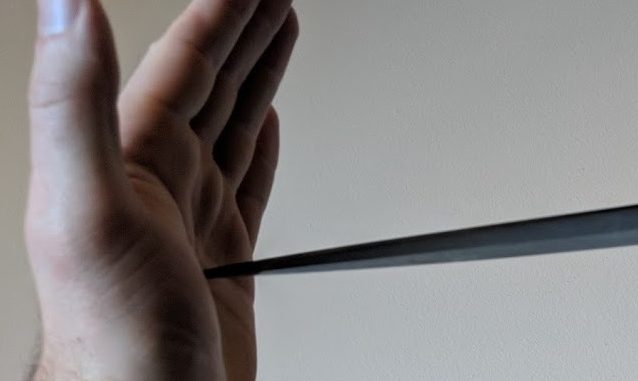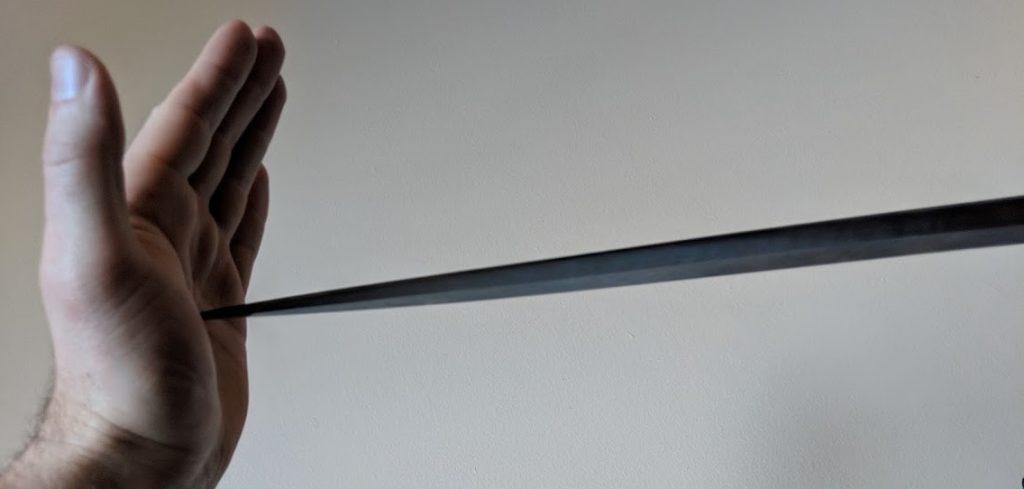
Ok, here we go for another round of “things you didn’t pay attention in high school physics class because the teacher wasn’t on the ball enough to relate them to swords”.
I’ve heard the saying tossed around
“It only takes 4 ounces of pressure for a sword thrust to pierce the body.”
Before we go all terminological on the quote we have to first consider the intent of the phrase: to communicate that you don’t need to be landing massively powerful thrusts to do damage. This is something true, and in that sense the quote has done its job.
But we are here to expand our minds, so let’s take a look at it:
- Ounces is a measure of force*, not pressure.
- The actual pressure required in a thrust is extremely high.
- I have no idea if that number is accurate or where it came from. Additionally (being Canadian) I don’t really have an intuitive sense for how much an ounce is other than ‘less than a pound’.
If any of these weren’t obvious to you, then read on! (Well, maybe the last one isn’t so important.)
*I don’t know if ounces is actually a measure of force or mass, and I don’t care to look it up for such a anachronistic method of measurement. ;P
Force
In addition to being a method to empower space wizards, force is (to really dumb it down) stuff pushing on other stuff. You want to lift a sword above your head? You need to exert force on it to make it move. The more force you put on it the faster you can make it move. If something is moving fast and hits something, there is a large amount of force exerted in order to slow it down.
All force isn’t equal. The timeframe in which the force is delivered can be really important to what effects it has, and it’s really a whole article in itself. For now we are talking about pressure.
Pressure
Pressure is how we transmit the force between two objects. The definition of pressure is fairly straightforward.
![]()
You can increase pressure in two ways: increase the force, or decrease the surface area. A fairly simple demonstration:
- Take a sharp sword and push the pommel into your hand.
- Now take the point and push it into your hand with the same force*.
*Don’t do this
What do we notice? Probably nothing because you already had an intuitive enough understanding not to stab yourself in the hand. If you didn’t let me know because I would find it hilarious.

The difference here is the surface area. The pommel is probably something like 300 mm2. The point is more like 0.0001 mm2. Which means that even though you are pushing equally hard, the point is exerting 3 million times more pressure on your hand.
The skin can only withstand so much pressure before it tears, which means that by concentrating all that force into a single point we can cause damage.
Cuts vs Thrusts
This is also why you need much more training and technique to be able to do damage with a cut. While the edge and the point are (should be?) sharpened equally well, the edge will have a much larger surface in contact with the target.

Using these numbers, the thrust delivers 6,000 times as much pressure as a cut! This is why when cutting you need to have good blade rotation to increase the tip speed as much as possible, or if you want to deliver a slice you have to deliver a lot of force on your opponent in addition to the draw.
Conclusion
So how does that affect your fencing? What can we take away from this?
Aside from the possibility of a few people who learned not to stab themselves in the hand, not all that much. (Unless you were one of those people who mistakenly believed that it was a trivial task to make a sword cut). Hopefully I’ve just made the world a marginally better place, with more people who can apply the correct terminology to what they are doing. And now know that the 4 ounces of force you are applying to the thrust is probably producing something like 2 million PSI of pressure.
Nerdy Footnotes
From papers on knife sharpening I usually see ranges of 1 μm to 5 μm for edge radius of extremely sharp vs somewhat sharp knives. For simplicity’s sake I modeled the tip as a circle with a diameter of 10 μm, and the edge as a rectangle 10 μm wide.
The edge length of 50 mm was arrived at by me pressing a ruler on to my head, and using my other hand to tell how much edge contact I can get. This is a somewhat crude measurement, but seeing as the contact length is going to be massively variable depending on where you hit, it’s good enough to illustrate the point.

